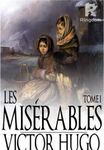42 books
-
1. O Coringa Possessivo

Vicente, vulgo coringa dono do morro Tietê assumiu ainda muito novo depois que seu pai morreu em um confronto com a polícia. Ele mata sem piedade é possessivo e quando quer da um jeito de conseguir, sempre se considerou hétero até ver o novo morador. Noah um menino de personalidade forte depois de ser expulso de casa pelo pai por assumir a sexualidade resolve ir morar no morro Tietê e faz amizade com a irmã do dono da p***a toda, enfrenta quem for e não teme o perigo.
-
2. Les Misérables

Les Misérables by Victor Hugo Les Misérables (/leɪ ˌmɪzəˈrɑːbəl, -blə/, French: [le mizeʁabl(ə)]) is a French historical novel by Victor Hugo, first published in 1862, that is considered one of the greatest novels of the 19th century.In the English-speaking world, the novel is usually referred to by its original French title. However, several alternatives have been used, including The Miserables, The Wretched, The Miserable Ones, The Poor Ones, The Wretched Poor, The Victims, and The Dispossessed.Beginning in 1815 and culminating in the 1832 June Rebellion in Paris, the novel follows the lives and interactions of several characters, particularly the struggles of ex-convict Jean Valjean and his experience of redemption.Examining the nature of law and grace, the novel elaborates upon the history of France, the architecture and urban design of Paris, politics, moral philosophy, antimonarchism, justice, religion, and the types and nature of romantic and familial love. Les Misérables has been popularized through numerous adaptations for film, television and the stage, including a musical.
-
3. A Vida Dupla de Júlia

Júlia, uma menina rebelde de uma família de advogados renomados, ela faz todo o possível para irritar seus pais. Gosta de se aventurar e em uma de suas travessuras ela encontra dois rapazes que faz sua vida virar de cabeça para baixo, um CEO um tanto preservado e um traficante obsessivo. O que será que a vida irá reservar para Júlia?
-
4. LOVIATAR

Un grupo de mercenarios que son reclutados para que ayuden en una misión en la ciudad de Odrick, una secta con filiaciones masoquistas, está preparando un ritual para traer a Loviatar, la diosa de la peste y el dolor a la tierra, en el trayecto se van envolviendo en una historia oscura de fantasía, acción y misterio, ¿serán capaces de detenerlas?
-
5. Les Misérables

The only completely unabridged ebook edition of Victor Hugo’s masterpiece—a sweeping tale of love, loss, valor, and passion. Les Misérables ranks among the greatest novels of all time. In it, Victor Hugo takes readers deep into the Parisian underworld, immerses them in a battle between good and evil, and carries them to the barricades during the uprising of 1832 with a breathtaking realism that is unsurpassed in modern prose.
-
6. El Proyecto Viling

Tras observar un evento inusual en el espacio, se ha descubierto un nuevo satélite en Júpiter al que nombran Viling, este despierta el interés de las grandes potencias mundiales debido a su valor comercial, Pero antes deciden enviar una misión tripulada para investigar las condiciones comerciales, los 7 tripulantes de la nave, se verán en medio situaciones que pondrán a prueba su capacidad de sobrevivir y su integridad mental, mientras paralelamente en la tierra, en la carrera por capitalizar el comercio espacial se desarrolla una trama de Conspiraciones, Enigmas, Traiciones e Intrigas que sellaran el destino del universo mismo. Finalmente, todo se complica cuando descubren que Viling no es precisamente un mundo solitario.
-
8. I miserabili

EDIZIONE REVISIONATA 10/02/2020. I miserabili viene pubblicato per la prima volta in Belgio nel 1862. In quegli anni Victor Hugo si trova in esilio sull’isola di Guernesey, davanti al golfo di Saint-Malo, dove lo ha costretto un decreto di Luigi Napoleone, divenuto imperatore grazie al colpo di stato del 1851. L’opera di Victor Hugo, insieme alla sua attività politica, viene infatti considerata rivoluzionaria. Massimo esponente del romanticismo in Francia, lo scrittore non si limita a parlare dei sentimenti umani, ma descrive nelle sue opere le condizioni reali della gente, le ingiustizie della società francese e le difficoltà quotidiane del popolo. I protagonisti del suo romanzo non sono personaggi di fantasia, ma i veri “miserabili” della Francia del tempo, le vittime reali delle disuguaglianze che si perpetrano nel paese e dei drammi sociali di quell’epoca: emarginati, prostitute, famiglie indigenti, lavoratori sfruttati, bambini costretti a crescere troppo in fretta… Hugo denuncia la drammatica situazione in cui si trovano migliaia di persone attraverso le vicende di Jean Valjean, un “miserabile” costretto a scontare vent’anni di prigione per aver rubato del pane, che riacquisterà, la sua dignità di uomo.
-
9. The Hunchback of Notre Dame

The Hunchback of Notre-Dame (French: Notre-Dame de Paris, lit. "Our Lady of Paris") is a French Gothic novel by Victor Hugo, published in 1831. The novel"s original French title, Notre-Dame de Paris, refers to Notre Dame Cathedral, on which the story is centered. Frederic Shoberl"s 1833 English translation was published as The Hunchback of Notre Dame (which became the generally used title in English), which refers to Quasimodo, Notre Dame"s bellringer. Extract | A few years ago, while visiting or, rather, rummaging about Notre-Dame, the author of this book found, in an obscure nook of one of the towers, the following word, engraved by hand upon the wall:— ??ÁG??. These Greek capitals, black with age, and quite deeply graven in the stone, with I know not what signs peculiar to Gothic caligraphy imprinted upon their forms and upon their attitudes, as though with the purpose of revealing that it had been a hand of the Middle Ages which had inscribed them there, and especially the fatal and melancholy meaning contained in them, struck the author deeply. He questioned himself; he sought to divine who could have been that soul in torment which had not been willing to quit this world without leaving this stigma of crime or unhappiness upon the brow of the ancient church. Afterwards, the wall was whitewashed or scraped down, I know not which, and the inscription disappeared. For it is thus that people have been in the habit of proceeding with the marvellous churches of the Middle Ages for the last two hundred years. Mutilations come to them from every quarter, from within as well as from without. The priest whitewashes them, the archdeacon scrapes them down; then the populace arrives and demolishes them. Thus, with the exception of the fragile memory which the author of this book here consecrates to it, there remains to-day nothing whatever of the mysterious word engraved within the gloomy tower of Notre-Dame,—nothing of the destiny which it so sadly summed up. The man who wrote that word upon the wall disappeared from the midst of the generations of man many centuries ago; the word, in its turn, has been effaced from the wall of the church; the church will, perhaps, itself soon disappear from the face of the earth. It is upon this word that this book is founded. March, 1831...|
-
10. Notre-dame de Paris

Victor Marie Hugo (26 February 1802 – 22 May 1885) was a French poet, novelist, and dramatist of the Romantic movement. Hugo is considered to be one of the greatest and best-known French writers. Outside France, his most famous works are the novels Les Misérables, 1862, and The Hunchback of Notre-Dame (French: Notre-Dame de Paris), 1831. In France, Hugo is known primarily for his poetry collections, such as Les Contemplations (The Contemplations) and La Légende des siècles (The Legend of the Ages). Notre-Dame de Paris, ("Our Lady of Paris") is a French Romantic/Gothic novel by Victor Hugo, published in 1831. The story is set in Paris in 1482 during the reign of Louis XI. The gypsy Esmeralda (born as Agnes) captures the hearts of many men, including those of Captain Phoebus and Pierre Gringoire, but especially Quasimodo and his guardian Archdeacon Claude Frollo. Translated by Isabel F. Hapgood
-
11. Les Miserables

Les Miserables is one of Hugo's greatest masterpieces and one of the greatest French novels of all times. It is set during the student revolutions in France and follows lives of several different characters. At the opening the narrator tells a story of a Frenchman imprisoned for stealing bread. After fleeing a police officer he agrees to care for a factory worker's daughter and this changes their lives forever.
-
12. Les misérables : Tome 1 Fantine

Oeuvre immense, joyau du patrimoine littéraire national, riche en figures assimilées par notre imaginaire ou notre langue, c"est roman touffu mais d"une lecture aisée, populaire mais déroutant, qu"il faut avoir lu. Jean Valjean, un ancien forçat condamné en 1796, trouve asile, après avoir été libéré du bagne et avoir longtemps erré, chez Mgr Myriel, évêque de Digne. Il se laisse tenter par les couverts d"argent du prélat et déguerpit à l"aube. Des gendarmes le capturent, mais l"évêque témoigne en sa faveur et le sauve. Bouleversé, Jean Valjean cède à une dernière tentation en détroussant un petit Savoyard puis devient honnête homme. En 1817 à Paris, Fantine a été séduite par un étudiant puis abandonnée avec sa petite Cosette, qu"elle a confiée à un couple de sordides aubergistes de Montfermeil, les Thénardier. Elle est contrainte de se prostituer...
-
14. Notre-Dame de Paris-1482

Notre-Dame de Paris est un roman historique de l’écrivain français Victor Hugo, publié en 1831. Le titre fait référence à la cathédrale de Paris, Notre-Dame, qui est un des lieux principaux de l’intrigue du roman.|Wikipédia| Extrait | Il y a quelques années qu’en visitant, ou, pour mieux dire, en furetant Notre-Dame, l’auteur de ce livre trouva, dans un recoin obscur de l’une des tours, ce mot gravé à la main sur le mur : ???G??. Ces majuscules grecques, noires de vétusté et assez profondément entaillées dans la pierre, je ne sais quels signes propres à la calligraphie gothique empreints dans leurs formes et dans leurs attitudes, comme pour révéler que c’était une main du moyen-âge qui les avait écrites là, surtout le sens lugubre et fatal qu’elles renferment, frappèrent vivement l’auteur. Il se demanda, il chercha à deviner quelle pouvait être l’âme en peine qui n’avait pas voulu quitter ce monde sans laisser ce stigmate de crime ou de malheur au front de la vieille église. Depuis, on a badigeonné ou gratté (je ne sais plus lequel) le mur, et l’inscription a disparu. Car c’est ainsi qu’on agit depuis tantôt deux cents ans avec les merveilleuses églises du moyen-âge. Les mutilations leur viennent de toutes parts, du dedans comme du dehors. Le prêtre les badigeonne, l’architecte les gratte, puis le peuple survient, qui les démolit. Ainsi, hormis le fragile souvenir que lui consacre ici l’auteur de ce livre, il ne reste plus rien aujourd’hui du mot mystérieux gravé dans la sombre tour de Notre-Dame, rien de la destinée inconnue qu’il résumait si mélancoliquement. L’homme qui a écrit ce mot sur ce mur s’est effacé, il y a plusieurs siècles, du milieu des générations, le mot s’est à son tour effacé du mur de l’église, l’église elle-même s’effacera bientôt peut-être de la terre. C’est sur ce mot qu’on a fait ce livre. Février 1831...|
-
15. Toilers of the Sea
First published in 1866 This version published in 1911. Edited by Ernest Rhys Translated by W. Moy Thomas I Dedicate This Book To The Rock Of Hospitality And Liberty, To That Portion Of Old Norman Ground, Inhabited By The Noble Little Nation Of The Sea, To The Island Of Gurnsey, Severe Yet Kind, My Present Asylum, Perhaps My Tomb.--V.H. A Tale Which Holdeth Children From Play, and Old Men From The Chimney Corner--Sir Philip Sidney This book is about human nature, and Nature. This book is about love, and solitude, it is about pride, but the true one, the one pride that matters, the one for ourself, the one that does not involves "showing off". And Victor chose, his classical way to go, and extreme situation, involving characters somehow outcast... Describing the sea and the island in a way he must really have learned because he was "stranded" there for a while... I love this book, reading it in a 100 years old translation from French, as well as in a recent one. Enjoy.--Submitted by Luigi Marchionni
-
16. Les Misérables

Extrait : "Cosette était maigre et blême. Elle avait près de huit ans, on lui en eût donné à peine six. Ses grands yeux enfoncés dans une sorte d'ombre profonde étaient presque éteints à force d'avoir pleuré. Les coins de sa bouche avaient cette courbe de l'angoisse habituelle, qu'on observe chez les condamnés et chez les malades désespérés."
-
18. Notre-Dame de Paris

Extrait : "La jeune fille se jeta sur lui comme une tigresse furieuse, et le poussa sur les marches de l'escalier avec une force surnaturelle. - Va-t'en, monstre ! va-t'en, assassin ! laisse-moi mourir ! Que notre sang à tous deux te fasse au front une tache éternelle ! Etre à toi, prêtre ! jamais ! jamais ! Rien ne nous réunira, pas même l'enfer ! Va, maudit ! jamais !"







